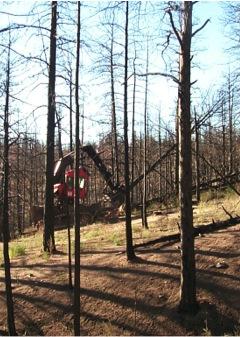After a wildfire burns a large swath across timberlands, logging companies come in to do salvage logging - they clean up the timber that has not been completely destroyed by the fire. It's a good idea to get economic benefit from devastated land and otherwise it is just rotting tinder for the next fire.
Environmentalists, who object to even the most basic forest management in order to prevent fires, hate logging - even after a fire has burned the place down. They have been raising the alarm about salvage logging because the ecological effects are...unknown.
Except they are known. A decade of data on salvage logging in Montana, Colorado and Washington contains information on the ground cover, soil compaction, sediment in water runoff and regrowth of vegetation compared to control plots that were not logged after a fire. 
Feller bunchers are heavy equipment used in salvage logging to cut down burned trees and pile them up. Credit: Michigan Tech
The data show that there is more sediment runoff after a fire - but there would be anyway. The trails made by the most commonly used equipment, such as feller bunchers - heavy machines that drive uphill, cutting and piling up trees - and skidders, which pick up the piles of trees and drag them back downhill, do lead to increase runoff, though only on small plots.
Sediment going downhill was greater where feller bunchers and skidders were used but it was also greater where they weren't. Clearing the land allows new growth to come in, so over the long term, sediment would be less. In the early days, the more firmly compacted ground becomes, the less water can soak in and the more runoff and erosion can occur.
Sediment is a concern because it can cause flooding if streams and reservoirs get clogged. At one of the study sites, where the Hayman fire burned 140,000 acres of the Pike-San Isabel National Forest in central Colorado, the sediment runoff was so bad that one of the main reservoirs serving Denver had to be dredged, though that was not due to salvage logging.
How to have the best of both worlds?
Salvage logging operations, unless required to do otherwise, will leave the small branches and treetops on the ground. This material, called slash, helped ameliorate the erosion and sediment problem, the researchers found.
Joseph Wagenbrenner, assistant professor in Michigan Technological University's School of Forest Resources and Environmental Science, and colleagues published results of a salvage logging study in Forest Ecology and Management and the team's recommendations for best management practices for salvage logging include:
- Leave slash on the ground
- Break up long feller-buncher and skidder trails with "water bars" - mounds of dirt that slow and divert runoff.
- De-compact the soil after heavy equipment is used.
- Consider replanting vegetation, which works better than slash because it roots in the soil.





Comments